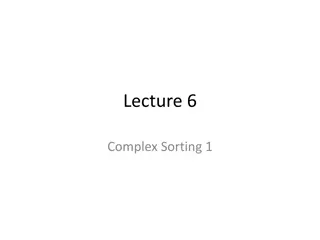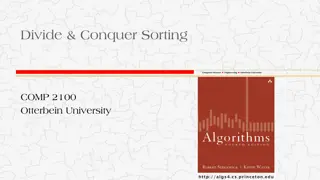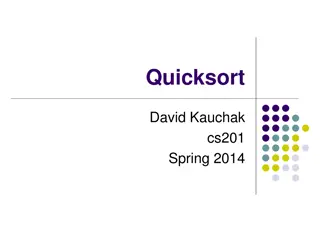
Quick Sorting and Selecting Algorithm Overview
"Learn about the Quick Sorting and Quick Selecting Divide-and-Conquer sorting algorithm with a time complexity of O(n log n) for sorting and finding the Kth smallest element in an unsorted array. Explore the basic ideas, partitioning techniques, and implementation details of this efficient algorithm."
Uploaded on | 0 Views
Download Presentation

Please find below an Image/Link to download the presentation.
The content on the website is provided AS IS for your information and personal use only. It may not be sold, licensed, or shared on other websites without obtaining consent from the author. If you encounter any issues during the download, it is possible that the publisher has removed the file from their server.
You are allowed to download the files provided on this website for personal or commercial use, subject to the condition that they are used lawfully. All files are the property of their respective owners.
The content on the website is provided AS IS for your information and personal use only. It may not be sold, licensed, or shared on other websites without obtaining consent from the author.
E N D
Presentation Transcript
Quick Sorting & Quick Selecting Divide-and-Conquer Sorting Algorithm with Time-Complexing of O(n log n) Algorithm for finding the Kth smallest element in unsorted array at O(n)
Basic Ideas Pick an element, say P (the pivot) Re-arrange the elements into 3 sub-blocks, those less than or equal to ( ) P (the left-block S1) the pivot (the only element in the middle-block) those greater than or equal to ( ) P (the right block S 2 ) Repeat the process recursively for the left- and right- sub-blocks. Return {quicksort( S 1), P, quicksort( S 2) }. 1. L: 2. P: 3. G:
Basic Ideas Note: The main idea is to find the right position for the pivot element P. After each pass , the pivot element, P, should be in place . Eventually, the elements are sorted since each pass puts at least one element (i.e., P) into its final position. Issues: How to choose the pivot P ? How to partition the block into sub-blocks?
Implementation : Quick Sort function // low --> Starting index // high --> Ending index void quicksort (arr[], low, high) { if (low < high) { // pi is partitioning index // arr[pi] is now at right place pi = partition(arr, low, high); quickSort(arr, low, pi - 1); quickSort(arr, pi + 1, high); } } // Before pi // After pi
Implementation : Partitioning function // This function sorts the array into left sub-block, pivot, right sub-block // and returns pivot index int partition (int arr[], int low, int high) { int pivot = arr[high]; // pivot int i = (low - 1); // Index of smaller element for (int j = low; j <= high-1; j++) { if (arr[j] <= pivot) { // If current element is smaller than or equal to pivot i++; // increment index of smaller element swap(&arr[i], &arr[j]); } } swap(&arr[i + 1], &arr[high]); return (i + 1); }
Driver Code #include<stdio.h> // A utility function to swap two elements void printArray(int arr[], int size) { int i; for (i=0; i < size; i++) printf("%d ", arr[i]); printf("n"); } // Driver program to test above functions int main() { int arr[] = {10, 7, 8, 9, 1, 5}; int n = sizeof(arr) / sizeof(arr[0]); quickSort(arr, 0, n-1); printf("Sorted array: n"); printArray(arr, n); return 0; } void swap(int* a, int* b) { int t = *a; *a = *b; *b = t; }
Why Quick Sort is preferred over Merge Sort for sorting Arrays? Quick Sort in its general form is an in-place sort (i.e. it doesn t require any extra storage) whereas merge sort requires O(N) extra storage, N denoting the array size which may be quite expensive. But because it has the best performance in the average case for most inputs, Quicksort is generally considered the fastest sorting algorithm. Allocating and de-allocating the extra space used for merge sort increases the running time of the algorithm. Comparing average complexity we find that both type of sorts have O(N log N) average complexity but the constants differ..
Quick Select Finding the Kth smallest element in an unsorted array
Implementation : This function returns k'th smallest element in arr[l..r] using QuickSort based method. ASSUMPTION: ALL ELEMENTS IN ARR[] ARE DISTINCT int kthSmallest(int arr[], int l, int r, int k) { if (k > 0 && k <= r - l + 1) { int index = partition(arr, l, r); if (index - l == k 1) { return arr[index]; } if (index - l > k - 1) { return kthSmallest(arr, l, index - 1, k); } return kthSmallest(arr, index + 1, r, k - index + l - 1); } else { return INT_MAX; } //Only if k is in the range of the array // Partition the array and get new position of pivot // If position is same as k // If position is more, recur for left subarray






















